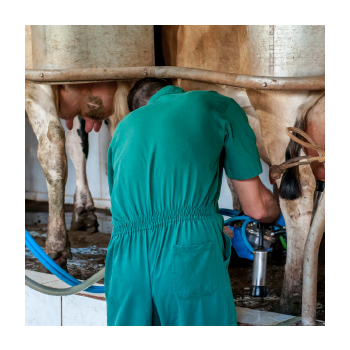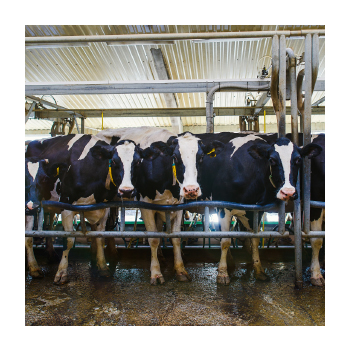 Workers in the CAFO "farming" machine, churning out everything from butter to bacon, have few resources to ensure their health and safety. Civil Eats reports that "Federal OSHA protections don't apply to 96 percent of the animal agriculture operations that hire workers in America."3 Thanks to a loophole created in 1976, the Occupational Health and Safety Administration (OSHA) has no jurisdiction over farms employing 10 or fewer non-family workers.4 5 And while CAFOs hold thousands of animals, modern automation means they can often operate with 10 or fewer human laborers.6
Workers in the CAFO "farming" machine, churning out everything from butter to bacon, have few resources to ensure their health and safety. Civil Eats reports that "Federal OSHA protections don't apply to 96 percent of the animal agriculture operations that hire workers in America."3 Thanks to a loophole created in 1976, the Occupational Health and Safety Administration (OSHA) has no jurisdiction over farms employing 10 or fewer non-family workers.4 5 And while CAFOs hold thousands of animals, modern automation means they can often operate with 10 or fewer human laborers.6
A report, co-authored by the Worker Justice Center of New York, investigating the plight of the state's immigrant dairy farmworkers estimates that more than 80 percent are employed at facilities falling outside OSHA jurisdiction.7 How do they fare? Two-thirds of workers surveyed have experienced one or more on-the-job injuries, with 68 percent of those severe enough to require medical attention.8 Crushed limbs, broken bones, head kicks from aggressive animals, and chemical-induced eye injuries were some of the most frequently reported.9 Animal agriculture-related fatalities that have been reported to OSHA over the last 20 years include drowning in manure pits, being gored by bulls, and suffocating in grain bins.10 And, from CAFO barns to slaughterhouses, amputations caused by equipment or crushing injuries from moving animals are commonplace.11 Still, Civil Eats found that less than 25 percent of severe injuries reported in animal ag operations from 2015 to 2021 received follow-up inspections by OSHA, including those resulting in amputations, eye loss, or hospitalization.12
Air pollutants, including poisonous gases, particulate matter, and endotoxins, are also an ever-present threat to CAFO workers' wellbeing.13 14 Yet, many workers aren't given personal protective equipment (PPE) or made aware of the health hazards these chemicals present, so when they do have PPE, they often don't use it.15 Meanwhile, the pervasiveness of occupational respiratory diseases can be as high as 30 percent among factory farm workers.16
A lack of training heightens the risks CAFO workers face.17 One-third of those surveyed in the New York dairy report said they hadn't received any job training. For others, protecting milk quality was the sole focus, with no information on worker safety.18 Another survey of immigrant laborers at Midwest cattle feedlots found that 40 percent hadn't received any safety training, but more than 90 percent were interested in receiving it.19
One risk management strategy CAFO owners are using is breaking up each segment of operation into separate limited liability companies (LLCs).20 Civil Eats reports that this allows groups of farmer investors to run CAFOs through third-party management companies, making it even harder to "decipher ownership, file lawsuits, and demand action on health and safety issues."21 22
 At the end of an exhausting CAFO workday, this harsh fact remains—most farmworkers are also the most vulnerable to employer abuses. An estimated 73 percent of U.S. agricultural workers are immigrants—doing jobs that U.S. citizens often don't want.23 And, in dairy specifically, the expected minimum of immigrant labor is 51 percent, with many undocumented.24 Yet, if this workforce disappeared, experts say milk prices would rise by as much as 90 percent and the dairy industry would collapse.25
At the end of an exhausting CAFO workday, this harsh fact remains—most farmworkers are also the most vulnerable to employer abuses. An estimated 73 percent of U.S. agricultural workers are immigrants—doing jobs that U.S. citizens often don't want.23 And, in dairy specifically, the expected minimum of immigrant labor is 51 percent, with many undocumented.24 Yet, if this workforce disappeared, experts say milk prices would rise by as much as 90 percent and the dairy industry would collapse.25
Imagine you’re walking through the grocery store, watching people piling milk, pork chops, and burgers in their carts—food you can’t afford but that your labor helped deliver—and you think to yourself, "I just want them to know about us."26
References
- Carly Fox, Rebecca Fuentes, Fabiola Ortiz Valdez, Gretchen Purser, and Kathleen Sexsmith. 2017. “Milked: Immigrant Dairy Farmworkers in New York State.” A report by the Workers’ Center of Central New York and the Worker Justice Center of New York.
- “Injured and Invisible.” Civil Eats, 10 Mar. 2023, civileats.com/injured-and-invisible/.
- “Injured and Invisible.” Civil Eats, 10 Mar. 2023, civileats.com/injured-and-invisible/.
- Wozniacka, Gosia. “CAFO Workers Say They Can’t Breathe.” Civil Eats, 21 Dec. 2022, civileats.com/2022/11/15/animal-agriculture-workers-say-they-cant-breath-respiratory-health-cafos-ppe/.
- Cooke, Christina. “Animal AG Workers Face Many Hazards with Few Protections.” Civil Eats, 21 Dec. 2022, civileats.com/2022/11/14/injured-and-invisible-1-few-protections-animal-agriculture-workers-cafos-dairy-migrants-injuries/.
- Wozniacka, Gosia. “CAFO Workers Say They Can’t Breathe.” Civil Eats, 21 Dec. 2022, civileats.com/2022/11/15/animal-agriculture-workers-say-they-cant-breath-respiratory-health-cafos-ppe/.
- Carly Fox, Rebecca Fuentes, Fabiola Ortiz Valdez, Gretchen Purser, and Kathleen Sexsmith. 2017. “Milked: Immigrant Dairy Farmworkers in New York State.” A report by the Workers’ Center of Central New York and the Worker Justice Center of New York.
- Carly Fox, Rebecca Fuentes, Fabiola Ortiz Valdez, Gretchen Purser, and Kathleen Sexsmith. 2017. “Milked: Immigrant Dairy Farmworkers in New York State.” A report by the Workers’ Center of Central New York and the Worker Justice Center of New York.
- Carly Fox, Rebecca Fuentes, Fabiola Ortiz Valdez, Gretchen Purser, and Kathleen Sexsmith. 2017. “Milked: Immigrant Dairy Farmworkers in New York State.” A report by the Workers’ Center of Central New York and the Worker Justice Center of New York.
- Cooke, Christina. “Animal AG Workers Face Many Hazards with Few Protections.” Civil Eats, 21 Dec. 2022, civileats.com/2022/11/14/injured-and-invisible-1-few-protections-animal-agriculture-workers-cafos-dairy-migrants-injuries/.
- Cooke, Christina. “Animal AG Workers Face Many Hazards with Few Protections.” Civil Eats, 21 Dec. 2022, civileats.com/2022/11/14/injured-and-invisible-1-few-protections-animal-agriculture-workers-cafos-dairy-migrants-injuries/.
- Cooke, Christina. “Animal AG Workers Face Many Hazards with Few Protections.” Civil Eats, 21 Dec. 2022, civileats.com/2022/11/14/injured-and-invisible-1-few-protections-animal-agriculture-workers-cafos-dairy-migrants-injuries/.
- Wozniacka, Gosia. “CAFO Workers Say They Can’t Breathe.” Civil Eats, 21 Dec. 2022, civileats.com/2022/11/15/animal-agriculture-workers-say-they-cant-breath-respiratory-health-cafos-ppe/.
- “Dangerous Working Conditions on Factory Farms: FFAC.” Factory Farming Awareness Coalition, 3 Jan. 2022, ffacoalition.org/articles/dangerous-conditions-factory-farms/.
- Wozniacka, Gosia. “CAFO Workers Say They Can’t Breathe.” Civil Eats, 21 Dec. 2022, civileats.com/2022/11/15/animal-agriculture-workers-say-they-cant-breath-respiratory-health-cafos-ppe/.
- Horrigan, Leo, et al. “How Sustainable Agriculture Can Address the Environmental and Human Health Harms of Industrial Agriculture.” Environmental Health Perspectives, May 2002, www.ncbi.nlm.nih.gov/pmc/articles/PMC1240832/.
- Cooke, Christina. “Animal AG Workers Face Many Hazards with Few Protections.” Civil Eats, 21 Dec. 2022, civileats.com/2022/11/14/injured-and-invisible-1-few-protections-animal-agriculture-workers-cafos-dairy-migrants-injuries/.
- Carly Fox, Rebecca Fuentes, Fabiola Ortiz Valdez, Gretchen Purser, and Kathleen Sexsmith. 2017. “Milked: Immigrant Dairy Farmworkers in New York State.” A report by the Workers’ Center of Central New York and the Worker Justice Center of New York.
- Ramos, Athena K., et al. “A Preliminary Analysis of Immigrant Cattle Feedyard Worker Perspectives on Job-Related Safety Training.” MDPI, 2 Sept. 2018, www.mdpi.com/2313-576X/4/3/37#B13-safety-04-00037.
- Cooke, Christina. “Animal AG Workers Face Many Hazards with Few Protections.” Civil Eats, 21 Dec. 2022, civileats.com/2022/11/14/injured-and-invisible-1-few-protections-animal-agriculture-workers-cafos-dairy-migrants-injuries/.
- Cooke, Christina. “Animal AG Workers Face Many Hazards with Few Protections.” Civil Eats, 21 Dec. 2022, civileats.com/2022/11/14/injured-and-invisible-1-few-protections-animal-agriculture-workers-cafos-dairy-migrants-injuries/.
- Wozniacka, Gosia. “CAFO Workers Say They Can’t Breathe.” Civil Eats, 21 Dec. 2022, civileats.com/2022/11/15/animal-agriculture-workers-say-they-cant-breath-respiratory-health-cafos-ppe/.
- “Immigrant Farmworkers and America’s Food Production - 5 Things to Know.” FWD.Us, 14 Sept. 2022, www.fwd.us/news/immigrant-farmworkers-and-americas-food-production-5-th….
- Carly Fox, Rebecca Fuentes, Fabiola Ortiz Valdez, Gretchen Purser, and Kathleen Sexsmith. 2017. “Milked: Immigrant Dairy Farmworkers in New York State.” A report by the Workers’ Center of Central New York and the Worker Justice Center of New York.
- Carly Fox, Rebecca Fuentes, Fabiola Ortiz Valdez, Gretchen Purser, and Kathleen Sexsmith. 2017. “Milked: Immigrant Dairy Farmworkers in New York State.” A report by the Workers’ Center of Central New York and the Worker Justice Center of New York.
- Carly Fox, Rebecca Fuentes, Fabiola Ortiz Valdez, Gretchen Purser, and Kathleen Sexsmith. 2017. “Milked: Immigrant Dairy Farmworkers in New York State.” A report by the Workers’ Center of Central New York and the Worker Justice Center of New York.




 Workers in the CAFO "farming" machine, churning out everything from butter to bacon, have few resources to ensure their health and safety. Civil Eats reports that "Federal OSHA protections don't apply to 96 percent of the animal agriculture operations that hire workers in America."3 Thanks to a loophole created in 1976, the Occupational Health and Safety Administration (OSHA) has no jurisdiction over farms employing 10 or fewer non-family workers.4 5 And while CAFOs hold thousands of animals, modern automation means they can often operate with 10 or fewer human laborers.6
Workers in the CAFO "farming" machine, churning out everything from butter to bacon, have few resources to ensure their health and safety. Civil Eats reports that "Federal OSHA protections don't apply to 96 percent of the animal agriculture operations that hire workers in America."3 Thanks to a loophole created in 1976, the Occupational Health and Safety Administration (OSHA) has no jurisdiction over farms employing 10 or fewer non-family workers.4 5 And while CAFOs hold thousands of animals, modern automation means they can often operate with 10 or fewer human laborers.6 At the end of an exhausting CAFO workday, this harsh fact remains—most farmworkers are also the most vulnerable to employer abuses. An estimated 73 percent of U.S. agricultural workers are immigrants—doing jobs that U.S. citizens often don't want.23 And, in dairy specifically, the expected minimum of immigrant labor is 51 percent, with many undocumented.24 Yet, if this workforce disappeared, experts say milk prices would rise by as much as 90 percent and the dairy industry would collapse.25
At the end of an exhausting CAFO workday, this harsh fact remains—most farmworkers are also the most vulnerable to employer abuses. An estimated 73 percent of U.S. agricultural workers are immigrants—doing jobs that U.S. citizens often don't want.23 And, in dairy specifically, the expected minimum of immigrant labor is 51 percent, with many undocumented.24 Yet, if this workforce disappeared, experts say milk prices would rise by as much as 90 percent and the dairy industry would collapse.25

